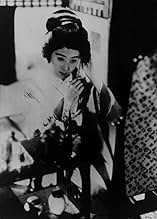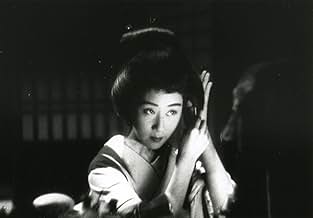NOTE IMDb
7,4/10
3,2 k
MA NOTE
Deux soeurs geishas mènent une vie difficile dans le quartier de Gion à Kyoto. Lorsque l'une d'elles se sent obligée d'aider un homme d'affaires ruiné, sa soeur imagine plusieurs scénarios p... Tout lireDeux soeurs geishas mènent une vie difficile dans le quartier de Gion à Kyoto. Lorsque l'une d'elles se sent obligée d'aider un homme d'affaires ruiné, sa soeur imagine plusieurs scénarios pour se débarrasser de lui.Deux soeurs geishas mènent une vie difficile dans le quartier de Gion à Kyoto. Lorsque l'une d'elles se sent obligée d'aider un homme d'affaires ruiné, sa soeur imagine plusieurs scénarios pour se débarrasser de lui.
- Réalisation
- Scénario
- Casting principal
- Récompenses
- 1 victoire au total
Namiko Kawashima
- Oemi Furusawa
- (as Kazuko Kuno)
Fumio Ôkura
- Jurakudo, the antiques dealer
- (as Fumio Okura)
Avis à la une
This movie, about two geisha sisters who lead a hard life in the Gion district of Kyoto, is a good drama movie!
I personally do not have much to say about it. The movie is not amazing or incredible for my part, but it has some funny moments where the main plot is the most compelling element. It feels slow at times, but fortunately, it is quite short to be a feature film, and it is also nicely shot and the actors do good. I am glad I took it a visit because I had a good time!
Despite not being a masterpiece, this movie is a good drama with humor and a strong plot. Solid acting and visuals make it worth a watch.
I personally do not have much to say about it. The movie is not amazing or incredible for my part, but it has some funny moments where the main plot is the most compelling element. It feels slow at times, but fortunately, it is quite short to be a feature film, and it is also nicely shot and the actors do good. I am glad I took it a visit because I had a good time!
Despite not being a masterpiece, this movie is a good drama with humor and a strong plot. Solid acting and visuals make it worth a watch.
"Sisters of Gion" is a Japanese film directed by Kenji Mizoguchi. It apparently must be very well thought of, as it's part of a set of Mizoguchi films in a DVD set from the artsy Criterion Collection. While I could see the artistry of the cinematography, I wasn't super-impressed by the story. It left me a bit flat.
When the film begins, it looks a bit like a Yasujirô Ozu film because the camera in set at a level about that of a person sitting on the floor. And, like Ozu, the camera lens does not move back or forth.--it's a stationary box. But, unlike Ozu, while the cameraman does not move the camera, it does move on a track--making for an incredibly interesting opening shot. In fact, the film is full of interesting shots--with unusual angles, composition and depth. It's almost like the camera is a tiny one that is peeking into rooms--and it's very nice--probably the nicest looking Japanese cinematography from this era that I have seen.
Now the story of "Sisters of Gion" ("Gion No Shimai") is not particularly enjoyable--mostly because the folks in it aren't particularly likable and the story is only mildly interesting--except, perhaps, to someone wanting insight into the role of women in 1930s Japan. This aspect of the film is unusual--how one woman embraces power and her sister embraces conventionality and kindness. It's obvious the film was not meant as a feel-good film but a sad portait of the lives of women in the lower classes.
A man has just lost his business and moves in with the geisha he used to sponsor. You might have felt sorry for him, but in the process he left his family and seemed very self-involved. This geisha he goes to is a very nice and dutiful woman, as she is under no obligation to take him in but she does. However, her younger sister, also a geisha, is rather conniving and VERY practical. She will get a wealthy sponsor one way or another. This, ultimately, leads to a rather interesting relationship with Mr. Kimura--but you'll have to see that for yourself. I'd say that the acting, camera-work and direction were good. But I just didn't care a lot for the characters or their problems--though the story was darkly compelling and provocative.
When the film begins, it looks a bit like a Yasujirô Ozu film because the camera in set at a level about that of a person sitting on the floor. And, like Ozu, the camera lens does not move back or forth.--it's a stationary box. But, unlike Ozu, while the cameraman does not move the camera, it does move on a track--making for an incredibly interesting opening shot. In fact, the film is full of interesting shots--with unusual angles, composition and depth. It's almost like the camera is a tiny one that is peeking into rooms--and it's very nice--probably the nicest looking Japanese cinematography from this era that I have seen.
Now the story of "Sisters of Gion" ("Gion No Shimai") is not particularly enjoyable--mostly because the folks in it aren't particularly likable and the story is only mildly interesting--except, perhaps, to someone wanting insight into the role of women in 1930s Japan. This aspect of the film is unusual--how one woman embraces power and her sister embraces conventionality and kindness. It's obvious the film was not meant as a feel-good film but a sad portait of the lives of women in the lower classes.
A man has just lost his business and moves in with the geisha he used to sponsor. You might have felt sorry for him, but in the process he left his family and seemed very self-involved. This geisha he goes to is a very nice and dutiful woman, as she is under no obligation to take him in but she does. However, her younger sister, also a geisha, is rather conniving and VERY practical. She will get a wealthy sponsor one way or another. This, ultimately, leads to a rather interesting relationship with Mr. Kimura--but you'll have to see that for yourself. I'd say that the acting, camera-work and direction were good. But I just didn't care a lot for the characters or their problems--though the story was darkly compelling and provocative.
In the early days of film writing "Sisters" was often cited as one of the great films EVER; it is probably right that this quiet, measured film is now not viewed as such.
Still, I found it held my interest easily and was effecting. The acting is admirable, and the sadness of the women's plight are expressed without sentiment. Well worth seeing; 8 out of 10.
Still, I found it held my interest easily and was effecting. The acting is admirable, and the sadness of the women's plight are expressed without sentiment. Well worth seeing; 8 out of 10.
Mizoguchi creates a tiny universe with a few characters that somehow manages to maintain in balance throughout the entire film. This is achieved because every character feels real, that means they can be right and wrong and there is not a single character that has the absolute truth.
Very simple filmmaking precisely thought out. With no ostentation the director decides to stay in the shade and put the story and characters in the spotlight.
After watching It on DVD a couple of years ago, I got to see It on the big screen thanks to the Bilbao Art House Zinema.
After watching It on DVD a couple of years ago, I got to see It on the big screen thanks to the Bilbao Art House Zinema.
Umekichi, a geisha in the Gion district of Kyoto, feels obliged to help her lover Furusawa when he asks to stay with her after becoming bankrupt and leaving his wife. However her younger sister Omocha tells her she is wasting her time and money on a loser.
Here we have another film by Mizogucki looking at "fallen women", much like "Street of Shame" twenty years later, and to some degree "Osaka Elegy". But we also have a tale of the old and the new -- looking to the West and also sticking with tradition. This is especially interesting given the radical shift in Japanese culture after World War II.
I have not seen the remake and thus cannot compare them, but how do you top the work of Mizoguchi? You simply cannot.
Here we have another film by Mizogucki looking at "fallen women", much like "Street of Shame" twenty years later, and to some degree "Osaka Elegy". But we also have a tale of the old and the new -- looking to the West and also sticking with tradition. This is especially interesting given the radical shift in Japanese culture after World War II.
I have not seen the remake and thus cannot compare them, but how do you top the work of Mizoguchi? You simply cannot.
Le saviez-vous
- AnecdotesDaiichi Studio went into bankruptcy following the poor commercial results of the film.
- ConnexionsReferenced in Aru eiga-kantoku no shôgai (1975)
Meilleurs choix
Connectez-vous pour évaluer et suivre la liste de favoris afin de recevoir des recommandations personnalisées
Détails
- Date de sortie
- Pays d’origine
- Langue
- Aussi connu sous le nom de
- Sisters of the Gion
- Société de production
- Voir plus de crédits d'entreprise sur IMDbPro
Box-office
- Montant brut mondial
- 17 807 $US
- Durée
- 1h 9min(69 min)
- Couleur
- Rapport de forme
- 1.37 : 1
Contribuer à cette page
Suggérer une modification ou ajouter du contenu manquant




















